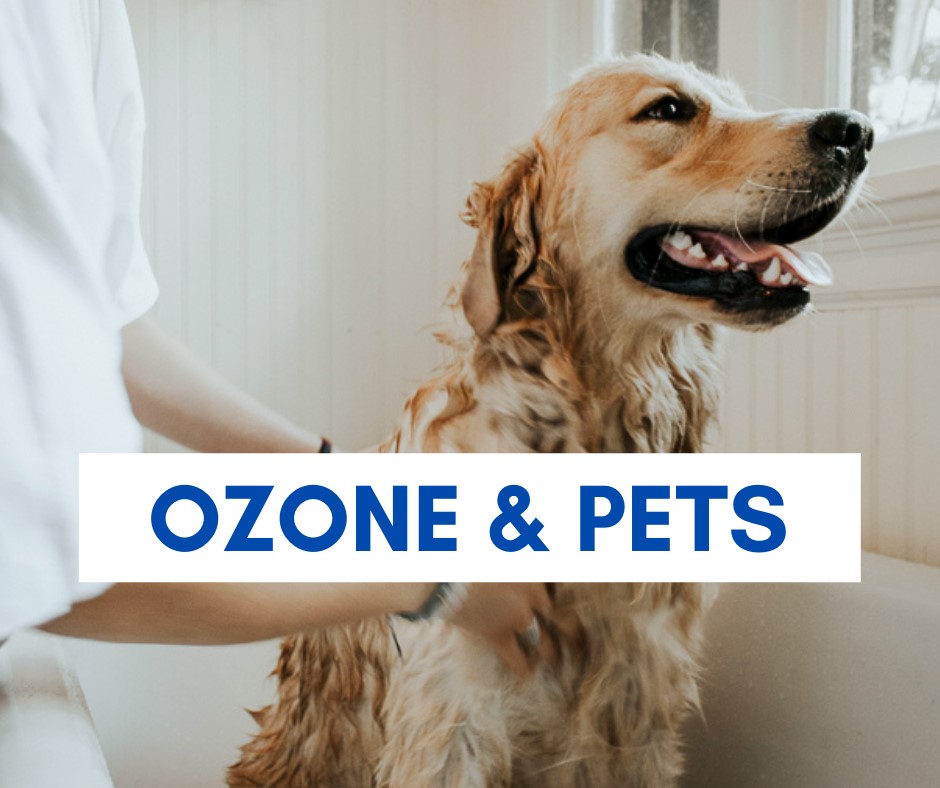Ozone gas is all around us. It is in our planet’s stratosphere and in the air we breathe. Ozone is also a very common disinfectant used in water, air and surface sterilization to keep the things we use everyday safe from harmful bacteria, viruses, parasites, minerals and other contaminates. Ozone can be utilized as a sterilizer in nearly any industry from transportation to home care and everything in between. Guidelines are put in place to keep ozone concentration under a certain limit when it is being used in an area occupied by anyone. When ozone concentration is over the specified limit, the people in the immediate area may experience some discomfort. We know this, it has been tested, limits defined, regulations put in place, and the cleaning power of ozone harnessed safely and effectively. One area of concern that may be present in the lives of many, is the safety of ozone around pets and animals.
Can ozone clean the messes brought upon us by our furry friends? Are animals more sensitive to even lower concentrations of ozone? And finally, how effective is as an cleaner compared to any of the other common cleaners we usually use to clean our animal companions’ messes? Let’s learn more about how we can use ozone more safely and effectively, making sure all of our family is living in a safe and comfortable environment.

Animal Safety
The regulations and guidelines set by governing bodies in each country regard the safe limit of ozone concentration around people and pets to be around 0.1ppm (parts per million). This is considered to be the standard for most of North America and Europe. Any higher than 0.1ppm is considered excessive, less than 0.1ppm would make the ozone less effective as a sterilizer. So at the international standard of 0.1ppm, is this level of ozone concentration safe for animals? Not only is 0.1ppm of ozone safe for animals, it is also being offered as therapy!
Hydrotherapy, is the process of pumping a basin full of water with ozone and placing usually voluntary animals into the water carefully so that the ozone infused water can coat their skin. This ozone infused water is believed to improve micro-circulation. This process leads to boosting oxygen into the animals skin, which also relieves inflammation, and alleviates infection. This type of process is being offered at more and more veterinaries across North America and Europe.
Cleaning Applications
From the magnitude of mess that a pet is capable of, to the frequency and sometimes repulsiveness, how can ozone possibly and effectively clean up after an animal? In certain areas and environments, messes may be purely due to nature. Having a large or small pet animal normally means regular traveling outside and then coming back into your home, or even making messes while just staying in the home. Will ozone be prepared for these types of clean ups? Yes, and in more ways than you may think. For example, when our beloved animal companions come back with a skunk smell, ozone can be used to more effectively remove the smell without the need of any heavy cleaners, or chemicals, or even messier tomato sauces.
Ozone can also remove dirt from the skin gently and safely along with each bath time when our curious critters go sneaking out and come back covered in whatever else that isn’t their natural skin colour. It does so with a nice mist of ozone infused water as a spray or gas cloud. Then the messes and odors are said to be more easily washed or even seemingly dissolved away.
Compared to other Common Cleaners
To put this into perspective, let’ s compare how ozone would deal with similar messes compared to the ones that we would normally use to clean with. These types of products are more chemically manufactured and mass-produced cleaning products. Alcohol is commonly used to treat wounds on animals and humans. Using alcohol routinely to treat singular areas on skin often also causes dryness and burning to that area over time. Ozone disinfects gently over the wound, leaving the skin healthy and allowing it to repair more quickly in less time.
Bleach and other multi-purpose cleaners are used to clean up after animal and human areas when we want to kill viruses and bacteria. Ozone is also prepared to take this challenge with a more soft and gentle approach. Ozone has the ability to kill 99.99% of viruses, bacteria, fungi, parasitic organisms in a similar way it is being used to treat wounds, clouds of ozone gas and ozone infused water mists.
Those of us who are willing to choose to adopt pets into our homes do so because of the love we have for that or those animals. Those animals then become a part of our families, and they also deserve all of the care, love and support that we are able to provide. Pets can be more sensitive than ourselves to the environment that we provide of them. We need to think about what is best for all of us, without cutting corners. Everyone deserves the right to a safe, healthy and comfortable living environment. The next time you go to clean up after your pet, think about if you are doing the best job possible. Are you really giving them the safe, clean space that they deserve as being a fellow family member, or could their space be even more clean, even more healthy, giving them an even more comfortable life. Do what is best for yourself, do what is best for your family, including your pets, and instead of cleaning with harmful chemicals, try sterilizing with ozone.


